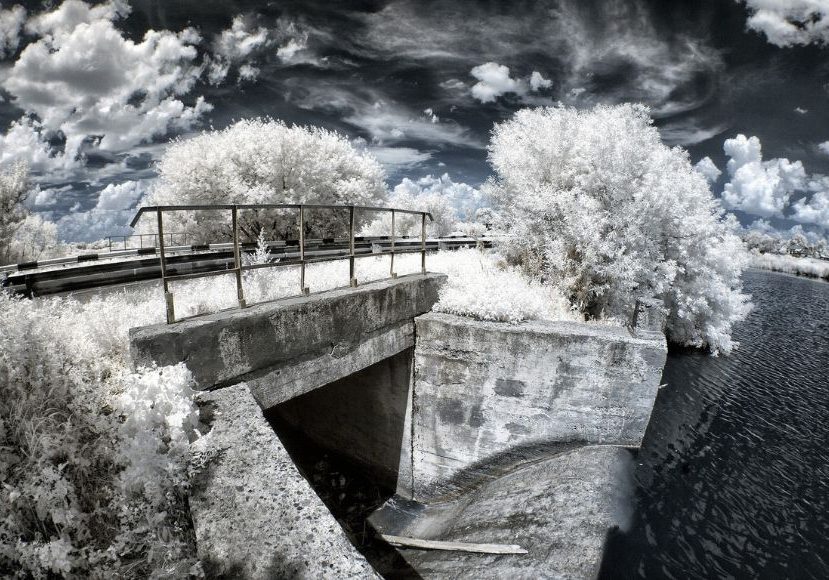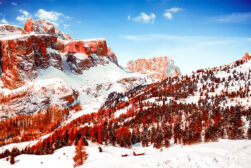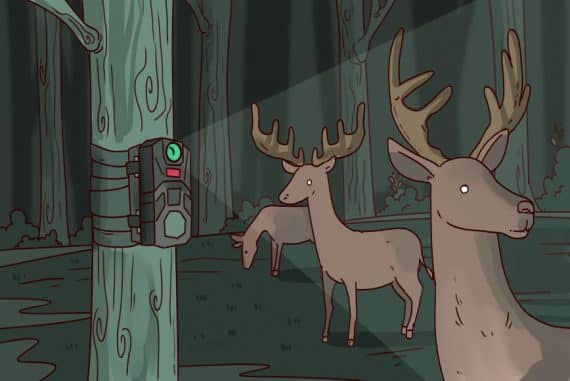
Explaining Infrared Colors in IR Photography
Dive into the mesmerizing realm of infrared photography and discover how it reveals a spectrum of colors invisible to the naked eye.
Learn | By Yatharth Gupta
If you wish to learn about infrared colors in IR photography, this article is for you.
Do you ever wonder how color works in infrared photography?
You must’ve seen how infrared photos depict elements in different colors; for example, plants are often pink, and water bodies are dark blue or black.
Even though IR photos look otherworldly and beautiful, there are various factors behind the color an object or surface displays in them.
In this article, I’ll cover everything from technical knowledge to practical aspects of color in infrared photography.
So, let’s get started.
Can We See Infrared Color?

We can’t see infrared color with our eyes because of two main reasons.
First, the infrared spectrum is outside the range of light signals that our eyes can perceive.
We can only see light in the wavelength range of 400 to 700 nanometers.
However, infrared light is a broad spectrum that begins at around 800 nm and goes to 1000000 nm. Our eyes cannot pick up these longer wavelengths.
Secondly, there’s no color in the infrared spectrum that can be directly seen by humans or even infrared camera sensors.
The colors we see in IR photos are applied to signify different reactions to infrared light.
They are not actual colors we naturally see in reality but are added during the image processing phase to represent the infrared light in a way we can understand.
What Do We Mean When We Say “Infrared Color”?

The term “Infrared Color” refers to the colors rendered by an infrared camera in a photo.
However, those colors are not the real colors because infrared cameras or filters that allow infrared light to pass through are designed to render colors in a specific way.
The color process in IR cameras is based on how different surfaces reflect or absorb infrared light.
So, when we capture images with infrared-enabled cameras, they translate the invisible light into visible colors, creating a unique look.
These cameras are built to see infrared light and capture it in a photo with substitute colors from the color spectrum that we can see.
This means the camera would assign a color based on its interaction with infrared light.
For example, due to the high reflectivity of infrared light, plants render deep pink or red, and water bodies render dark due to absorption.
How Much Do You REALLY Know About Photography?! 🤔
Test your photography knowledge with this quick quiz!
See how much you really know about photography...

In most cases, the rendered colors are shades and tints of blue and red; however, it depends largely on the camera’s programming in relation to the color.
What Are the Colors of the Infrared Spectrum?

The colors we see in IR photos are not the colors of the infrared light spectrum itself but rather a representation of how different materials respond to it.
In a way, infrared colors are a translation of the invisible light into visuals we can see.
When the interaction of infrared light is captured and converted into visible colors, it’s often represented in shades of red and blue, which are false colors.
The colors in images from infrared-equipped cameras are called false colors because they are a replacement for the invisible infrared spectrum from the visible range.
The color representation also depends on how infrared light interacts with a surface.
For example, vegetation, which reflects a lot of infrared light, might appear in bright tones of white or red, while water and skies may appear in deeper blues or even black as they absorb infrared light.
These contrasting colors create ethereal, dreamlike scenes, making familiar landscapes surreal.
How Are Infrared Colors Used?

Infrared colors are used in photography, where they serve both artistic and practical uses.
Artistically, infrared colors give you a unique aesthetic for your creative expression.
An infrared camera can turn ordinary landscapes into dreamlike scenes, offering a fresh take on the subjects we think we know well and revealing the details that are usually hidden from our eyes.
However, beyond art, infrared colors have practical applications in various fields.
Infrared photography is used in environmental studies to assess plant health, in astronomy to observe celestial bodies, and in law enforcement and military operations for surveillance, especially in low-light conditions.
In these scenarios, infrared colors can be programmed to help with various use cases, like identifying various elements, mapping thermal activity, etc.
Infrared imaging is also vital in medical diagnostics, building inspections, and even art restoration, where it helps reveal underlying layers or structures.
What Do Colors Actually Look Like in Infrared?

There’s no way to tell how colors look in infrared, as it’s outside our visible spectrum.
The colors we see in infrared photos taken with various modified infrared cameras are the result of conversion.
Specialized infrared equipment is designed to replace tones with different colors within the perceivable range based on various factors such as reflectance and absorption of IR radiation.
This conversion mechanism can differ for cameras based on how it was modified.
Often, white balance also plays a key role in how converted colors from an infrared camera look in a photo.
The colors rendered in infrared photography are often called ‘false colors’ as they are just a visual representation of the otherwise invisible infrared spectrum.
Also, similar to other genres of photography, infrared photographers often use post-processing to enhance the look and feel of the photos.
Let’s take a look at what color most infrared cameras render for various objects and natural elements.
Natural Elements and Their Infrared Appearance:
- Vegetation:
In IR photography, green plants, trees, and grass usually appear in white or light pink shades. This effect is due to chlorophyll’s high reflectance of infrared light in plants. The lush greenery, so vibrant in visible light, transforms into a snowy or glowing landscape in an IR photo. - Water Bodies:
Lakes, rivers, and oceans absorb infrared light rather than reflecting it, leading to their dark blue, often black, appearance in IR images. This stark contrast creates dramatic scenes, especially when juxtaposed against bright vegetation or skies. - Skies:
Infrared light is less scattered in the atmosphere than visible light, resulting in darker skies in IR photographs. This reduced Rayleigh scattering means that the blue sky, usually light and vibrant, appears deep and intense in infrared. - Buildings and Architecture:
The look of man-made structures like buildings and roads, etc., varies significantly in infrared photography. Materials like concrete, brick, and asphalt reflect infrared light in different degrees, rendering various shades of gray or white in infrared photography.
Human Skin:
Infrared light slightly penetrates under the human skin, which results in smooth and bright skin in infrared portrait photos.
For the same reason, veins closer to the skin’s surface stand out more under infrared light.

Clothes and Fabrics:
Dark fabrics reflect IR light in varying degrees based on their texture and material, often appearing lighter than expected in photos.
This can lead to surprising results where black clothing might appear gray or even white.
Infrared Sensor Frequencies and Color Rendering:
- Near-Infrared (800nm to 1000nm):
This range is closest to visible light and is most commonly used in IR photography.
Cameras and films sensitive to near-infrared light render images with subtle contrasts. - Mid and Far Infrared (1000nm to 50000nm):
These longer wavelengths are more commonly used in scientific and industrial applications.
They are less about capturing the aesthetic aspects of a scene and more about detecting thermal variations.
These wavelengths are not typically used in conventional IR photography for artistic purposes.
Factors Influencing Color Appearance in Infrared Photography:
- Material Reflectance:
Different materials reflect infrared light uniquely, significantly affecting the color appearance in IR images.
For instance, due to its high infrared reflectance, foliage looks drastically different from water or skies. - Camera Sensor and Filter:
The type of infrared sensor and the filters used also play a crucial role in the look of colors in photos.
Filters that are made to block visible light and only allow infrared light to pass through can significantly change how colors look in the final image. - Post-Processing:
Post-processing also greatly influences the colors in IR photography.
Exposure, temperature, and HSL adjustments allow photographers to enhance or change the color palette of an infrared image.
What Are the Colors in Infrared Photography?

The colors captured in infrared photography are not the actual colors but rather interpretations of infrared wavelengths.
They represent how infrared light reacts with different elements, surfaces, and materials.
Infrared cameras are made to perceive these interactions with infrared light and differentiate them in terms of color with image processing.
These interpretations vary significantly based on the camera’s sensor, the IR filter used, and image processing techniques.
That’s why we see infrared photos display various unreal yet beautiful colors.
Color perception in IR photography differs vastly from traditional photography.
Let’s take a look at the various colors typically seen in infrared images:
Whites and Light Pinks:
In IR photography, areas of high infrared reflectance often appear in white or light pink shades.
This is particularly true for vegetation such as leaves and grass, which reflect a significant amount of infrared light due to their chlorophyll content.
The resulting effect is often surreal, transforming green landscapes into ethereal, snowy vistas.
Deep Blacks and Grays:
Surfaces that absorb rather than reflect infrared light, such as water bodies and clear skies, tend to appear in deep blacks and grays.
This strong contrast is one of the typical features of IR photography, creating dramatic scenes where the water and sky provide a dark backdrop against brighter elements.

Monochrome in IR Photography:
Monochrome is mostly used in surveillance devices; you will often find an IR night mode in your CCTV cameras.
Monochrome imagery is not a direct result of the camera type but is a chosen functionality for processing the image.
This technique is used for its ability to emphasize contrasts, textures, and structural details of the subject, which might be less prominent in low light.
While infrared light itself doesn’t contain color as perceived by the human eye, monochrome processing is used to convert these images into grayscale.
Photographers also process their infrared photos in monochrome to convey a certain mood and artistic vision.
Does the Infrared Camera See Color?
Infrared cameras do not “see” color in the way human eyes do.
They detect infrared radiation, which falls outside the visible spectrum and is inherently colorless to the human eye.
The colors seen in IR photographs are created by translating infrared light into visible light during the image processing phase.

This translation is necessary because infrared light itself is not visible to the human eye.
The process involves converting the intensity and wavelengths of infrared radiation into colors within the visible spectrum.
This conversion is often achieved through the use of filters and post-processing techniques, where specific wavelengths of infrared light are assigned visible colors.
The colors in infrared photography are not true representations of the actual colors of objects but are interpretations of the infrared light they reflect or absorb.
This unique aspect of IR photography allows for creative and often otherworldly depictions of familiar scenes, making it a fascinating genre for photographers.
FAQ
Do the infrared photographs really contain infrared colors?
No, infrared photos don’t contain infrared colors, as the infrared light spectrum is outside our visible spectrum.
IR photos use converted wavelengths of infrared light into visible light spectrums.
Is color infrared photography remote sensing?
Color infrared photography can be used in remote sensing, as it captures data (infrared light) beyond our visual spectrum and interprets it into visible imagery.
What is the best color light for infrared?
There is little evidence on which color light is best for infrared photography.
However, sunlight is considered the best source of light when shooting infrared.
What color absorbs infrared best?
Dark colors, particularly black, absorb infrared radiation most effectively.
What colors emit infrared radiation?
Black and other dark colors emit the most infrared radiation as they absorb more light and heat.
What do the different colors do in an infrared sauna?
Infrared sauna uses various colors for chromotherapy, including red, yellow, green, blue, orange, and more.
Each color is said to have a different benefit, ranging from anti-aging and cell-renewal to smoother skin.
What are the dangers of infrared light?
In nature, infrared light is harmless to humans as it’s an invisible radiation by default.
However, prolonged exposure to man-made infrared radiation can cause eye defects, injuries, and other heat-related issues, primarily affecting the eyes and skin.

Check out these 8 essential tools to help you succeed as a professional photographer.
Includes limited-time discounts.













